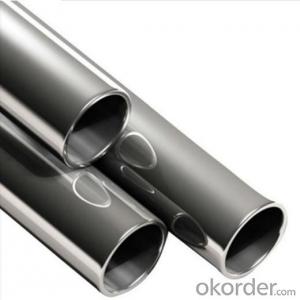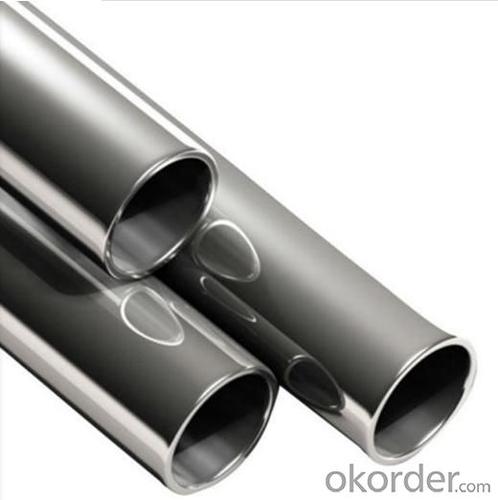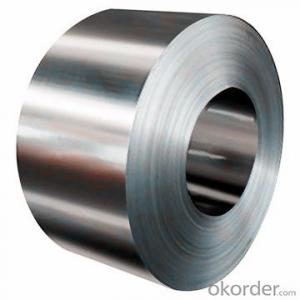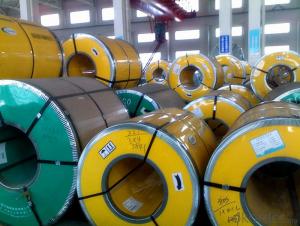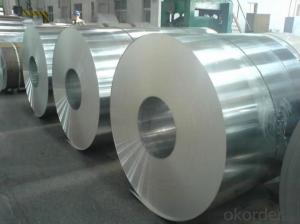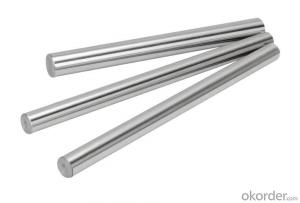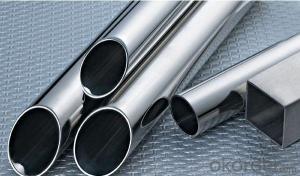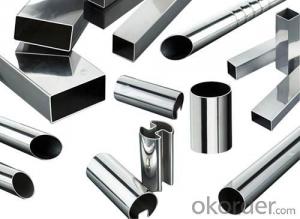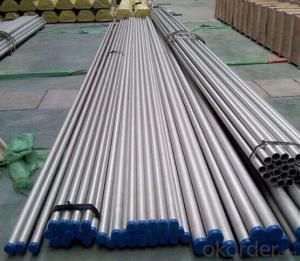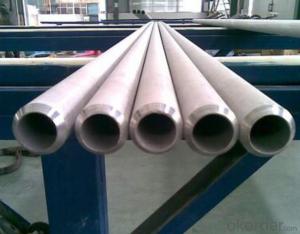304 stainless steel pipe with high quality
- Loading Port:
- China Main Port
- Payment Terms:
- TT OR LC
- Min Order Qty:
- 50 m.t.
- Supply Capability:
- 10000 m.t./month
OKorder Service Pledge
OKorder Financial Service
You Might Also Like
Stainless steel pipe
Description:
1) Grade: 201,202,301,304,304L,310S,316,316L,410,430,etc.
2) Standard: AISI, ASTM, DIN, GB, JIS, EN
3) Dimension: 3-400mm
4) Length: 2-6m or as customer decided
5) Condition: Hot Rolled & Pickled, Hot Rolled Black Bar,Cold Drawn,
6) Packing: export packing or according to client's requirement
Terms:
1) Loading Port: Shanghai
2) Delivery term: CFR
3) Delivery lead time:45 working days after received T/T or L/C deposit.
4) Payment term: .30% as deposit by T/T, balance will be paid by T/T against the copy of B/L. or LC at sight.
5) Quality assurance: Mill Test Certificate is supplied with shipment, third Party Inspection is acceptable.
Product Application:
With bright surface, slight magnetism and no cracks on forming, is widely used in bicycle fittings, kitchen and sanitation tools, goods shelf, pet cages, gill racks, decorative handles and baskets, food and medical machinery accesses, etc.
Chemical composition and physical properties:
Grade | C | Si | Mn | P | S | Ni | Cr | Cu | Mo | Ni |
304 | ≤ 0.07 | ≤1 | ≤ 2 | ≤ 0.045 | 0.15 ˜ 0.35 | ≤ 0.11 | 17.5 ˜ 19.5 | ≤ 1 | - | 8 ˜ 10 |
304L | ≤ 0.03 | ≤ 1 | ≤ 2 | ≤ 0.045 | ≤ 0.03 | ≤ 0.11 | 18 ˜ 20 | - | 2 ˜ 2.5 | 10 ˜ 12 |
316 | ≤ 0.07 | ≤1 | ≤ 2 | ≤ 0.045 | ≤ 0.03 | ≤ 0.11 | 16.5 ˜ 18.5 | - | 2t ˜ 205 | 10 ˜ 13 |
316L | ≤ 0.03 | ≤1 | ≤ 2 | ≤ 0.045 | ≤ 0.03 | ≤ 0.11 | 17 ˜ 19 | - | 2.5 ˜ 3 | 12.5 ˜ 15 |
410 | 0.08˜0.15 | ≤1 | 0.04 | 0.03 | - | - | 11.5 ˜ 13.5 | - | - | - |
430 | ≤ 0.08 | ≤1 | ≤1.5 | 0.04 | 0.03 | - | 12 ˜ 14 | - | - | - |
- Q: What are the different grades of stainless steel used for strips?
- There are various grades of stainless steel used for strips, each with different properties and applications. Some common grades include: 1. Austenitic stainless steel (e.g., 304, 316): This is the most widely used type of stainless steel for strips. It offers excellent corrosion resistance, high strength, and good formability. It is commonly used in food processing equipment, kitchen appliances, and architectural applications. 2. Ferritic stainless steel (e.g., 430): Ferritic stainless steel is known for its magnetic properties and high resistance to corrosion, especially in acidic environments. It is commonly used in automotive trim, kitchen utensils, and decorative strips. 3. Martensitic stainless steel (e.g., 410, 420): Martensitic stainless steel is known for its high strength, hardness, and wear resistance. It is commonly used in cutlery, surgical instruments, and industrial applications where hardness and corrosion resistance are required. 4. Duplex stainless steel (e.g., 2205): Duplex stainless steel offers a combination of high strength and corrosion resistance. It is commonly used in chemical processing equipment, oil and gas pipelines, and marine applications. The choice of grade depends on the specific application and the desired properties such as corrosion resistance, strength, formability, and magnetic properties.
- Q: How do you prevent stainless steel strips from rusting?
- To prevent stainless steel strips from rusting, there are several measures you can take: 1. Regular cleaning: Stainless steel should be cleaned regularly with mild soap or detergent and warm water. This helps remove any dirt, grime, or contaminants that can promote corrosion. 2. Avoid abrasive cleaners: Harsh or abrasive cleaners can scratch the surface of stainless steel, creating micro-abrasions where rust can start. Stick to non-abrasive cleaners and soft cloths or sponges for cleaning. 3. Dry thoroughly: After cleaning, make sure to dry the stainless steel strips completely. Moisture left on the surface can lead to rust formation. Use a clean, dry cloth or towel to remove any remaining moisture. 4. Remove rust spots promptly: If you notice any rust spots forming on the stainless steel strips, it's crucial to remove them as soon as possible. Use a stainless steel cleaner or a mixture of baking soda and water to gently scrub away the rust. Rinse thoroughly and dry the area to prevent further corrosion. 5. Apply a protective coating: There are various protective coatings available specifically designed for stainless steel. These coatings create a barrier between the metal and the environment, preventing rust formation. Follow the manufacturer's instructions for application and reapplication. 6. Avoid contact with corrosive substances: Stainless steel should be kept away from corrosive substances such as acids, bleach, or saltwater. If contact occurs, immediately rinse the affected area with plenty of clean water and dry it thoroughly. 7. Store in a dry environment: When not in use, it's essential to store stainless steel strips in a dry environment. Moisture and humidity can contribute to rust formation. Consider using desiccant packs or silica gel to absorb any moisture in the storage area. By following these preventative measures, you can significantly reduce the chances of your stainless steel strips rusting and ensure their longevity and appearance for years to come.
- Q: Are stainless steel strips suitable for chemical storage tanks?
- Indeed, chemical storage tanks can indeed benefit from the use of stainless steel strips. The remarkable corrosion resistance of stainless steel renders it a perfect choice for the containment of chemicals that possess corrosive or reactive characteristics. Its exceptional strength and durability guarantee that the tank can endure the weight and pressure exerted by its chemical contents. Furthermore, stainless steel's non-porous nature obstructs chemical absorption, thus preventing contamination. Its ease of cleaning and maintenance further minimizes the likelihood of cross-contamination between various chemicals. Ultimately, stainless steel strips offer a dependable and enduring solution for chemical storage tanks.
- Q: Can stainless steel strips be used in desalination plants?
- Yes, stainless steel strips can be used in desalination plants. Stainless steel is a corrosion-resistant material that can withstand the harsh conditions and high salt content found in desalination plants. It is commonly used for various components such as pipes, tubes, heat exchangers, and filters in desalination plants.
- Q: Are stainless steel strips resistant to acids and alkalis?
- Yes, stainless steel strips are generally resistant to acids and alkalis. Stainless steel contains chromium, which forms a passive oxide layer on the surface of the metal. This oxide layer acts as a barrier, protecting the underlying steel from corrosion. As a result, stainless steel is highly resistant to both acids and alkalis. However, the level of resistance can vary depending on the specific grade and composition of the stainless steel. Some grades may be more resistant to certain acids or alkalis than others. It is always recommended to consult the manufacturer or supplier for specific information on the resistance of a particular stainless steel grade to acids and alkalis.
- Q: What is the melting point of stainless steel strips?
- The melting point of stainless steel strips is subject to variation based on the specific alloy employed. Typically, the melting point of stainless steel strips falls within the range of 2,500 to 2,800 degrees Fahrenheit (1,370 to 1,540 degrees Celsius). Nevertheless, it should be emphasized that dissimilar grades or compositions of stainless steel might possess marginally diverse melting points.
- Q: Are stainless steel strips corrosion-resistant?
- Yes, stainless steel strips are corrosion-resistant. Stainless steel is a type of steel alloy that contains a minimum of 10.5% chromium, which forms a thin, protective layer on the surface of the steel called a passive film. This passive film is highly resistant to corrosion, making stainless steel strips suitable for various applications where corrosion resistance is essential. Additionally, stainless steel also contains other elements such as nickel and molybdenum, which further enhance its corrosion resistance properties. This makes stainless steel strips highly durable and able to withstand exposure to moisture, chemicals, and other corrosive environments without rusting or corroding.
- Q: Are 111 stainless steel strips resistant to intergranular corrosion?
- 111 stainless steel strips exhibit resistance to intergranular corrosion. This type of stainless steel, known as austenitic stainless steel, contains elevated levels of chromium and nickel, resulting in exceptional corrosion resistance. The carbon content and the presence of stabilizing elements like titanium or niobium determine the intergranular corrosion resistance in stainless steel. 111 stainless steel strips typically possess low carbon content, preventing the formation of chromium carbide precipitates along the grain boundaries and reducing susceptibility to intergranular corrosion. Furthermore, the abundant chromium and nickel content in 111 stainless steel encourages the formation of a protective oxide layer on the surface, further enhancing its corrosion resistance. As a result, 111 stainless steel strips are widely acknowledged for their strong resistance to intergranular corrosion.
- Q: Can stainless steel strips be used in the medical device manufacturing industry?
- Yes, stainless steel strips can be used in the medical device manufacturing industry. Stainless steel is a commonly used material in medical devices due to its corrosion resistance, high strength, and biocompatibility. It is often used in the production of surgical instruments, implants, and various medical equipment. The versatility and reliability of stainless steel make it an ideal choice for the demanding requirements of the medical device manufacturing industry.
- Q: What are the different types of stainless steel strip edges?
- Various applications commonly utilize different types of stainless steel strip edges. These options include: 1. Mill Edge: Generated during the hot rolling process, this standard edge features a slightly rounded shape and may contain some mill scale. 2. Slit Edge: Achieved by slicing the coil into narrower strips, this edge is characterized by a straight form, smooth surface, and absence of burrs. 3. Deburred Edge: Formed by eliminating any burrs or sharp edges from the slit edge, this type provides a smoother and safer finish. 4. Rounded Edge: By rounding the strip's sharp edges, this edge is frequently employed in safety-conscious industries like food production. 5. Beveled Edge: Created through the beveling of the strip at a specific angle, this edge finds application in scenarios requiring a tight fit or welding. The selection of a stainless steel strip edge depends on the specific application and desired outcome. Each edge type possesses unique advantages and may be suitable for varying purposes.
Send your message to us
304 stainless steel pipe with high quality
- Loading Port:
- China Main Port
- Payment Terms:
- TT OR LC
- Min Order Qty:
- 50 m.t.
- Supply Capability:
- 10000 m.t./month
OKorder Service Pledge
OKorder Financial Service
Similar products
Hot products
Hot Searches
Related keywords
